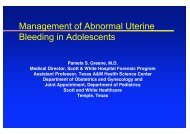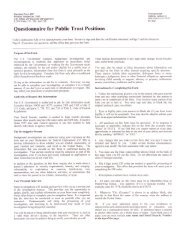Benign Paroxysmal Positional Vertigo - Healthcare Professionals
Benign Paroxysmal Positional Vertigo - Healthcare Professionals
Benign Paroxysmal Positional Vertigo - Healthcare Professionals
Create successful ePaper yourself
Turn your PDF publications into a flip-book with our unique Google optimized e-Paper software.
<strong>Benign</strong> <strong>Paroxysmal</strong> <strong>Positional</strong> <strong>Vertigo</strong> (BPPV)A Little Rock and Roll TalkThomas G. Brammeier, M.D., F.A.C.S.Director of the Hearing & BalanceCenter
Epidemiology of BPPV• Most common type of vertigo, approximately 25% occurrenceat the Scott & White, Hearing and Balance Center.• Increases with age. BPPV occurs in approximately 1-3% inteens to 30% in the elderly.• Age of onset occurs between 5 th and 7 th decade of life.• However, there is an increase in occurrence in elderly women(greater than 60 years of age), 2:1.1. Baloh R, et.al. Neurology 37:371, 1987. 2. Mizukoshi K, Acta Otolaryng. 447: 67, 1987 3. Froehling D, et al. Maya Clinic Proc 66:596, 1991
Etiology of BPPV• Primary BPPV is idiopathic.• occurrence rate is 50-70%.• Secondary BPPV can be caused by head trauma,migraines, Meniere’s disease, viral labyrinthitis,vestibular neuronitis, stapedectomy, perilymphfistula, or chronic otitis media.
Historical Background ofBPPV• 1921, Barany first described the manifestations of BPPV.• 1952, Dix and Hallpike described the classic maneuver.• 1969, Schuknecht described the otoconia floating from utricleinto the posterior semicircular canal.• 1992, Epley described the canalith repositioning maneuver, asthe Epley Maneuver.Otolaryngology Head & Neck Surgery, 3 rd edition, 1998.
Macula of the Utricle
Otoconia Particles
Pathophysiology of BPPV• Canalithiasis:• Free-floating otoconia particles come from the maculae of thelabyrinth and float into the posterior semicircular canal.• The posterior canal is the most gravity-dependent part of thevestibular labyrinth.• The mechanism of nystagmus is that the otoconia particles reacha critical mass load in the dependent portion of the posteriorcanal. When the head turns in the plane of the posterior canal,the inertia of otoconia critical mass load cause a fluid drag thatmust overcome the endolymph fluid pressure within the posteriorcanal to cause deflection of the cupula. This is the reason for thelatency and the cresendo nystagmus seen during the Dix-Hallpikemaneuver.
Pathophysiology of BPPVCanalithiasis:• The canalith critical mass load causes the movement ofendolyph fluid away from the cupula to induce ampullifugalcupular deflection causing an excitatory response. This causestorsional nystagmus in the plane of the posterior canal.(Ewald’s Law)• The nystagmus has limited duration because of endolymphfluid ceases when the canalith mass reaches the limit ofdescent within the semicircular canal.• Upon reversing the direction of endolymph fluid by the changein the position of the head, the nystagmus reverses direction.• The response is fatigable as the particles become dispersedalong the canal and become less effective in creatingendolymph fluid inertia and cupular deflection.Epley, Ann NY Academ Sci 2001 Cohen, Ann Otolaryng. 1964
Diagnosis of BPPVMedical history:• Intermittent vertigo associated with changes in headpositions, i.e. rolling over in bed, looking up, andbending over.• Duration is 20-30 seconds.• No fluctuation of hearing or tinnitus.• May have nausea, sweating, pallor and vomiting withsymptoms of vertigo.
Diagnosis of BPPVPast Medical History:• Migraines, Meniere’s disease, closed head injury,labyrinthitis, chronic otitis media, otosclerosis, andperilymphatic fistula.Physical Examination:• Normal except an abnormal (positive) Dix-Hallpiketest.Dix-Hallpike test is a very specific test, but notsensitive for the diagnosis of BPPV. Anabnormal (positive) Dix-Hallpike test mayindicate BPPV, but a normal Dix-Hallpike doesnot rule out BPPV.
Dix-Hallpike Test• Patient is sitting up on the table and the table istilted 30 degrees down.• The head is turned 45 degrees to the side beingtested.• Move the patient into the supine position whileholding the head 45 degrees toward the ear beingtested.• Always have an assistant help you with the patientpositioning.• Use Frenzel’s goggles or thick reading glasses toobserve the eyes.• Tests for the posterior semicircular canal on theside the head is turned.
Diagnosis of BPPVFive characteristics of BPPV1. Latency2. Short duration3. Reversibility4. Fatigability5. Direction
Diagnosis of BPPV1. Latency• After the positioning the patient will have apause of 2-10 seconds before the start of thenystagmus and symptoms of vertigo.2. Duration• The nystagmus and vertigo will last no longerthan 20-60 seconds.
Diagnosis of BPPV3. Reversibility• The direction of the nystagmus in thesupine position will reverse uponpositioning the patient in the sittingposition.4. Fatigability• Repeating the Dix-Hallpike test will resultin progressively milder symptoms ofvertigo and nystagmus.
Diagnosis of BPPV5. Direction• Depends directly on which labyrinthinesemicircular canal is affected by the otoconia.• 90-95% of the time, otoconia affects the posteriorsemicircular canal.• 5-7% of the time, otoconia affects the horizontalsemicircular canal.• Rarely affects the superior semicircular canal.Parnes, Neurotology 2ed.
Diagnosis of BPPVDirection of nystagmus• Posterior semicircular canal• Right ear down:• Nystagmus is down-beating (geotrophic) with torsionalclockwise movements.• Right ear up:• Nystagmus is up-beating (ageotrophic) with torsionalcounterclockwise movements.• Left ear down:• Nystagmus is down-beating (geotrophic) with torsionalcounterclockwise movements.• Left ear up:• Nystagmus is up-beating (ageotrophic) with torsionalclockwise movement.
Treatment of BPPVCanalith Repositioning Maneuver:Brammeier’s technique:During the entire canalith repositioning maneuver, the head is held inposition at 15-30 second intervals and the vibrator (oscillator) isapplied to the skull.1. The patient’s head is turned 45 degrees and the patient is lowered sothat the affected ear is tilted down at approximately 30 degrees fromthe horizontal plane. Hold this position for 15-30 seconds. Apply theoscillator to the skull bone.2. The patient’s is kept supine and the head is turned 45 degrees to themidline position. Hold this position for 15-30 seconds and continuewith the oscillator.
Treatment of BPPVCanalith Repositioning Maneuver:Brammeier’s technique:3. The patient is kept supine and the head is turned 45 degrees away.Hold this position for 15-30 seconds and continue with the oscillatoron the skull.4. Roll the patient on their side while holding the head in position. Turnthe head 45 degrees to the floor with the patient’s chin touching theshoulder. Hold this position for 30 seconds and continue with theoscillator.
Treatment of BPPVCanalith Repositioning Maneuver:Brammeier’s technique:5. Sit the patient up leaning over greater than 90 degrees with thehorizontal plane, the head in the midline position tilted slightlyforward. Have the patient lean over to the opposite side for 5seconds then in the center positioned. Hold this position for 15-30seconds and continue the oscillator. After 5-10 seconds, position thepatient 90 degrees and continue with the oscillator for the remaining10-20 seconds.6. Bring the head to the neutral position. May apply the soft neckcollar to wear for 24 hours.7. Follow up with a Dix-Hallpike test to confirm resolution of BPPV.
Problems and Complications withCanalith Repositioning Maneuver• Canalith jam• Caused by moving too fast through the canalithrepositioning maneuver. The otoconia particlesclog the semicircular canal and cause severevertigo.• Treatment: reverse the last two steps of thecanalith repositioning maneuver. The oscillatorhelps shakes the otoconia particles loose withinthe semicircular canal.
Problems and Complications withCanalith Repositioning Maneuver• Severe nausea and vomiting• Occurs approximately in 1-2% of patients.• Stop the procedure.• Make sure it is not a canalith jam.• Position the patient to allow for vomiting.• Treatment: May need to pre-medicate patient before attempting anothercanalith repositioning maneuver.• Try the canalith repositioning maneuver on a different day.• Neck pain• Contraindications for Dix-Hallpike testing and Canalith RepositioningManeuver include: history of recent neck trauma, severe cervicalrheumatoid arthritis, any cervical instability, cervical myelopathy orradiculopathy.• Always control the head and body movements with an assistant.
Problems and Complications withCanalith Repositioning Maneuver• Converting posterior BPPV to horizontal BPPV.• Moving too fast through the canalith repositioningmaneuver and not keeping the head tilted forwardin the last two steps of the procedure.• Occurs approximately 1-5%.• Failure for BPPV to resolve.• It is possible to have a recurrence within 1-2weeks after treatment.• Treating the wrong semicircular canal.• BPPV is not the true underlying problem.White, J. Cleveland Clinic Journal of Medicine Sept 2004
Treatment for BPPVOutcomes of Canalith Repositioning ManeuverNumerous published variations on the techniques of CanalithRepositioning Maneuver.• Greater than 80% effective on first repositioning maneuver.• Higher success after multiple repositioning maneuvers,oscillation, tilting the head in last two steps, and timing ofpositional changes.• Dr. Brammeier’s technique has overall an approximately95% success rate.• Recurrence rate of approximately 20%.White, J. Otology & Neurotology, 2005
















